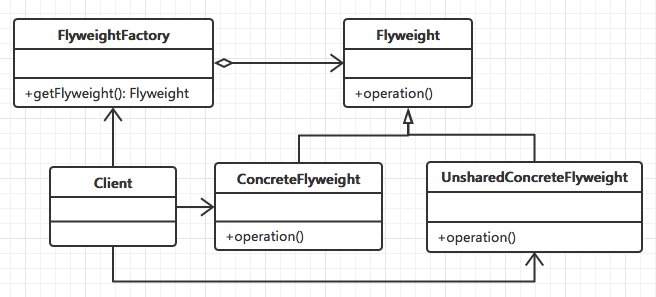声明:本博文篇幅短,适合review。
一、概念
运用共享技术,有效地支持大量细粒度的对象。减少内存消耗。它有两个状态:
内部状态:存储在享元对象内部,并且不会随环境改变而改变的对象,可以共享。
外部状态:随环境改变而改变的对象,不可共享。
二、结构模式图
class Flyweight
{
public:
virtual ~Flyweight();
virtual void Operation(const std::string & _others){}
std::string getState(){
return this->m_state;
}
protected:
Flyweight(std::string _state){
this->m_state = _state;
}
private:
std::string m_state;
};
class ConcreteFlyweight : public Flyweight
{
public:
ConcreteFlyweight(std::string _state) : Flyweight(_state) {}
~ConcreteFlyweight();
void Operation(const std::string & _others)
{
cout<<"ConcreteFlyweight Operation : "<<m_state<<endl;
};
};
class FlyweightFactory
{
public:
FlyweightFactory();
~FlyweightFactory();
Flyweight * getFlyweight(const std::string & key){
std::vector<Flyweight *>::iterator it = m_Vec.begin();
for (; it != m_Vec.end() ; it++){
if ( (*it)->getState() == key )
{
cout<<"has created"<<endl;
return *it;
}
}
Flyweight * fw = new ConcreteFlyweight(key);
m_Vec.push_back(fw);
return fw;
}
private:
std::vector<Flyweight *> m_Vec;
};
void main(){
FlyweightFactory * fc = new FlyweightFactory();
Flyweight * fw1 = fc->getFlyweight("xxx");
Flyweight * fw2 = fc->getFlyweight("yyy");
Flyweight * fw3 = fc->getFlyweight("xxx");
}三、例子
class Chess
{
public:
virtual ~Chess();
virtual void draw(const std::string & _color){}
std::string getState(){
return this->m_state;
}
protected:
Chess(std::string _state){
this->m_state = _state;
}
private:
std::string m_state;
};
class FiveChess : public Chess
{
public:
FiveChess(std::string _state) : Chess(_state) {}
~FiveChess();
void draw(const std::string & _color)
{
cout<<"FiveChess draw : "<<m_state<<" "<<_color<<endl;
};
};
class ChessFactory
{
public:
ChessFactory();
~ChessFactory();
Chess * getChess(const std::string & key){
std::vector<Chess *>::iterator it = m_Vec.begin();
for (; it != m_Vec.end() ; it++){
if ( (*it)->getState() == key )
{
cout<<"has created"<<endl;
return *it;
}
}
Chess * c = new FiveChess(key);
m_Vec.push_back(c);
return c;
}
private:
std::vector<Chess *> m_Vec;
};
void main(){
ChessFactory * cf = new ChessFactory();
Chess * c1 = cf->getChess("white");
c1.draw("白色");
Chess * c2 = cf->getChess("black");
c2.draw("黑色");
Chess * c3 = cf->getChess("white");
c3.draw("白色");
}四、优缺点
1、优点
a、极大的减少系统中对象的个数。
b、享元模式使得享元对象能够在不同的环境被共享。
2、缺点
a、使得系统更加复杂。为了使对象可以共享,需要将一些状态外部化,这使得程序的逻辑复杂化。
b、享元模式将享元对象的状态外部化,而读取外部状态使得运行时间稍微变长。























 7467
7467

 被折叠的 条评论
为什么被折叠?
被折叠的 条评论
为什么被折叠?








